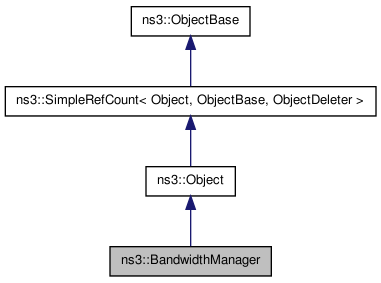This class manage the bandwidth request and grant mechanism. The bandwidth request and grant mechanism is supported by the Bandwidth Manager. Both BS and SS maintain a bandwidth manager. Furthermore BS's bandwidth manager works together with the uplink scheduler to determine total bandwidth available and allocation size for each service flow. Bandwidth request mechanism is a key feature of the WiMAX scheduler since all three non-UGS services explicitly request for bandwidth by sending a bandwidth request to BS. More...
#include <bandwidth-manager.h>


Public Member Functions | |
| BandwidthManager (Ptr< WimaxNetDevice > device) | |
| void | DoDispose (void) |
| uint32_t | CalculateAllocationSize (const SSRecord *ssRecord, const ServiceFlow *serviceFlow) |
| ServiceFlow * | SelectFlowForRequest (uint32_t &bytesToRequest) |
| void | SendBandwidthRequest (uint8_t uiuc, uint16_t allocationSize) |
| void | ProcessBandwidthRequest (const BandwidthRequestHeader &bwRequestHdr) |
| void | SetSubframeRatio (void) |
| uint32_t | GetSymbolsPerFrameAllocated (void) |
Detailed Description
This class manage the bandwidth request and grant mechanism. The bandwidth request and grant mechanism is supported by the Bandwidth Manager. Both BS and SS maintain a bandwidth manager. Furthermore BS's bandwidth manager works together with the uplink scheduler to determine total bandwidth available and allocation size for each service flow. Bandwidth request mechanism is a key feature of the WiMAX scheduler since all three non-UGS services explicitly request for bandwidth by sending a bandwidth request to BS.
Member Function Documentation
| void ns3::BandwidthManager::DoDispose | ( | void | ) | [virtual] |
This method is called by Object::Dispose or by the object's destructor, whichever comes first.
Subclasses are expected to implement their real destruction code in an overriden version of this method and chain up to their parent's implementation once they are done. i.e., for simplicity, the destructor of every subclass should be empty and its content should be moved to the associated DoDispose method.
It is safe to call GetObject from within this method.
Reimplemented from ns3::Object.
The documentation for this class was generated from the following file:
- src/devices/wimax/bandwidth-manager.h
 1.7.1
1.7.1